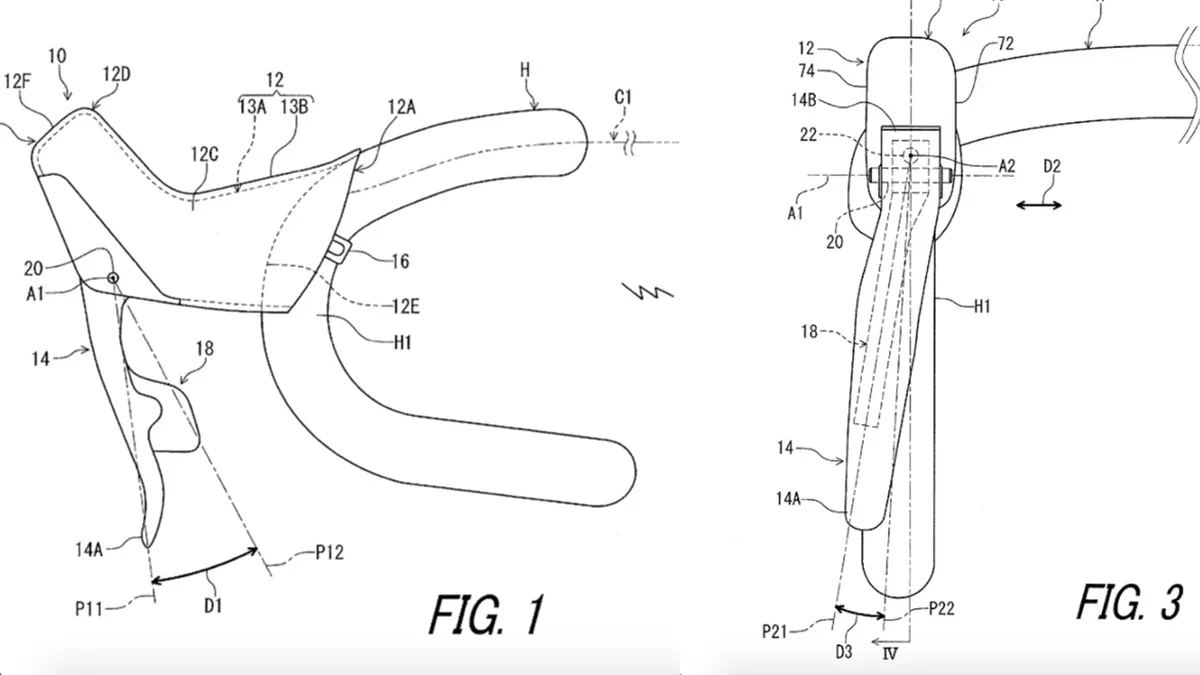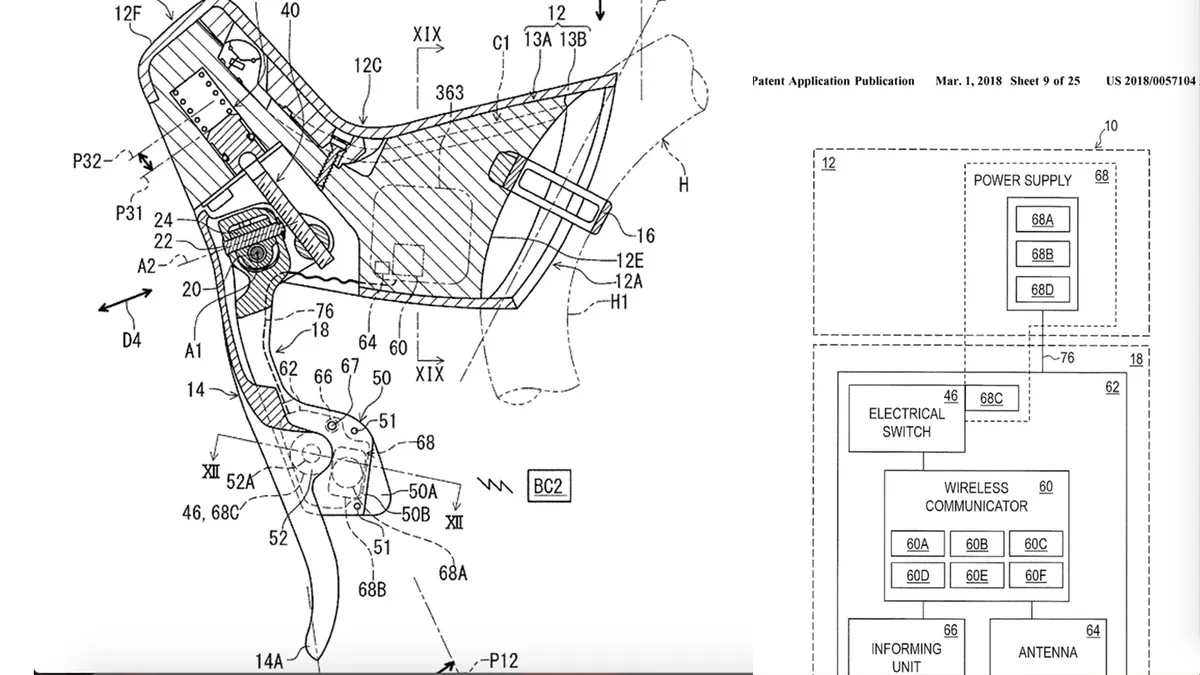Shimano recently received a patent filing from the USPTO for a wireless shifting system that appears to function much like the Japanese company's mechanical shifting configuration where the brake lever moves to shift in one direction and a smaller lever set behind shifts in the other direction.
Except in this patented design, the small lever movement triggers a button, and a wireless communicator sends a signal to a derailleur.... or a computer or a dropper seatpost or a suspension system.
The patent was filed in 2016, but was just published March 1, 2018. The illustrations look similar to SRAM's eTap HRD wireless hydraulic levers, but they were what were used in patent application 15/247,954, filed by SHIMANO INC, Sakai City, by inventors Komatsu, Nishino and Nakajima.
When reached by BikeRadar, Shimano declined to comment.
Shimano Di2 wireless hydraulic shifter patented
Levers, not buttons
In current Shimano Di2 systems for Dura-Ace and Ultegra, there are two buttons on each shifter, both of which sit behind the brake lever. These buttons can be configured in a variety of ways.
On the Dura-Ace Di2 levers there is also a button on the top of each hood, which can be configured to shift either derailleur, or to control newer Garmin Edge computers or certain ANT+ lights.
This new wireless shifter described in the patent filing resembles a mechanical Shimano Dura-Ace shift lever, in that there is a brake lever that pivots laterally to shift as well as fore/aft for braking. But instead of pulling a cable, the lateral movement triggers a button.
Similarly, there is a smaller lever with a paddle that sits behind the brake lever. This small lever swings in, just like a mechanical Shimano shifter, and triggers a button.
It is unclear whether the hood-top buttons would carry forward to this design.
All the schematics in the patent filing describe hydraulic-brake systems.

Shifters, computers, dropper posts and suspension
The patent filing describes the wireless shifting system as a "bicycle operating device," which "comprises a base member, an operating member, a hydraulic unit, an electrical switch, a wireless communicator, and a power supply."
Notably, the patent filing includes detail on an electric-energy generation element
The patent filing describes a regular drop-bar lever (with hydraulic braking), but notes that structures of the operating device could be used for other systems for "a flat handlebar, a time trial handlebar, and a bull horn handlebar."
Beyond derailleurs, the patent says the wireless setup could be used to control "an electric suspension, an electric seatpost and a digital device (e.g., a cycle computer, a cell phone or a music player)."
Powered by... movement and vibration?
The patent filing describes a battery and battery holder inside the hood. But the exact battery isn't specified. "Examples of the battery include a primary battery such as a lithium manganese dioxide battery," the patent reads. "In this embodiment, the battery is a primary button battery."
Notably, the patent filing includes detail on an electric-energy generation element. "The electric-energy generation element generates the electric energy using pressure and/or vibration. In this embodiment, the electric-energy generation element generates electric energy using pressure and/or vibration caused by a movement of at least one of the operation member [14, the main brake lever], the additional operating member [18, the inner shift lever], and the button element," the patent filing reads.
"Examples of the electric-energy generation element includes a piezo-electric element," the patent reads, referring to crystals that convert mechanical energy into electric energy.
The filing doesn't illustrate this component, though, noting that since the "electric-energy generation element and the rectifying circuit have been well known in the electronics field, they will not be described and/or illustrated in detail here for the sake of brevity."
It does note that the system could just scrap the piezoelectronics and just use a battery or batteries: "The electric-energy generation element and the rectifying circuit can be omitted from the power supply. The power source voltage is applied from the power supply to the wireless communicator."

Wireless system not specified
So will this 'wireless communicator' work on ANT+, Bluetooth or something else? That isn't clear.
"The signal generating circuit generates wireless signals based on the input operation received by the electrical switch," the filing reads. "The signal generating circuit superimposed digital signals on carrier wave using a predetermined wireless signal via the antenna."
The filing continues to read: "The signal generating circuit can encrypt control information (e.g., shift information) to generate encrypted wireless signals,"
Currently, Shimano's Di2 system uses Bluetooth for firmware updates, and, with the addition of a D-Fly unit, can send information on ANT+ for control of Garmin Edge computers or light systems.
Lights and maybe a buzzer
Speaking of lights, the filing describes how the shifter will have an LED or LED-like light.
"The informing unit is electrically connected to the wireless communicator," it reads. "The informing unit includes a light emitting element such as a light emitting diode (LED). However, the informing unit can include other elements such as a buzzer instead of or in addition to the light emitting element. Light from the informing unit is visible from outside of the bicycle operating device via a clear window."
It isn't clear what if any tactile feedback will be included in the shift system. There is a spring that opposes the shift movement for each lever.
Shimano declines to discuss the patent
BikeRadar has asked Shimano for comment, and received the typical boilerplate no-comment response: "Shimano is constantly in development of new products, but does not comment on rumors or speculation about products whether they are in development or not.”
p.p1 {margin: 0.0px 0.0px 0.0px 0.0px; font: 11.0px Calibri; color: #444444; background-color: #ffffff} span.s1 {font-kerning: none}
